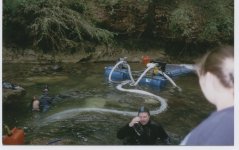flinthunter
Hero Member
- Jan 3, 2011
- 899
- 1,076
- Detector(s) used
- E-Trac, V3i, DFX
- Primary Interest:
- All Treasure Hunting
I'm doing some panning in a stream in Central Illinois and having a small amount of luck. The stream bed is mostly glacial sand and gravel but there is the occasional strip of bare solid clay.
I am thinking about using a spade to dig several artificial crevices/trenches in the clay that would run across the stream. Do you think this might capture some gold and if so, what are your recommendations for the depth, width, and angle of the trench sides (straight or tapered sides).
I've never read about anyone doing this and am looking forward to your opinions. Thank you.
I am thinking about using a spade to dig several artificial crevices/trenches in the clay that would run across the stream. Do you think this might capture some gold and if so, what are your recommendations for the depth, width, and angle of the trench sides (straight or tapered sides).
I've never read about anyone doing this and am looking forward to your opinions. Thank you.
Upvote
0










